Maintaining user engagement and satisfaction through a mobile app is no small feat in the dynamic and competitive telecom industry. As the digital front face for many telecom companies, these apps serve as a crucial touchpoint influencing customer loyalty and operational efficiency. This blog explores 8 key strategies that telecom providers can implement to improve telecom app engagement rate. From enhancing the user interface to leveraging the power of data analytics, each section delves into practical approaches that can transform how users interact with your app, ensuring it not only meets but exceeds user expectations.
TL;DR
- App engagement rate is a KPI measuring the degree of user interaction and involvement with your telco app.
- 71% of consumers prefer to engage with telcos through mobile apps.
- Currently, consumers perceive telco apps as utility tools but would prefer to have a single telco app that features multiple and diverse functions and features.
- Operators can improve telecom app engagement rate through:
- User-friendly interface
- Personalisation
- Gamification
- Push Notifications
- Interactive Features
- Social Sharing
- In-app Messaging
- Data Analytics
What is Telecom App Engagement Rate?
The Telecom app engagement rate is a key performance indicator (KPI) measuring the degree of user interaction and involvement with your telco mobile application.
App engagement doesn’t just mean the frequency of app usage but also the depth and quality of user involvement, usage habits, user lifespan, and the overall experience.
App engagement rate indicates how well your app meets the expectations and needs of your users over time.
How is telecom app engagement rate measured?
The engagement rate represents the average number of interactions the app receives per user. The interactions that indicate app engagement include:
- Sessions – when a user interacts with an app after installing it.
- Session length
- Daily active users (DAUs) or monthly active users (MAUs) – An active user is a user who engages with an app within a given period.
- Click-through rate (CTR)
- App opens per user
- Stickiness – how often users return to the app.
- Churn rate – the percentage of users who stop using an app within a specific time frame.
- App abandonment rate – the percentage of users who stopped using the app after one use.
- App store ratings
There are various methods of calculating app engagement rates. Below is one of them:
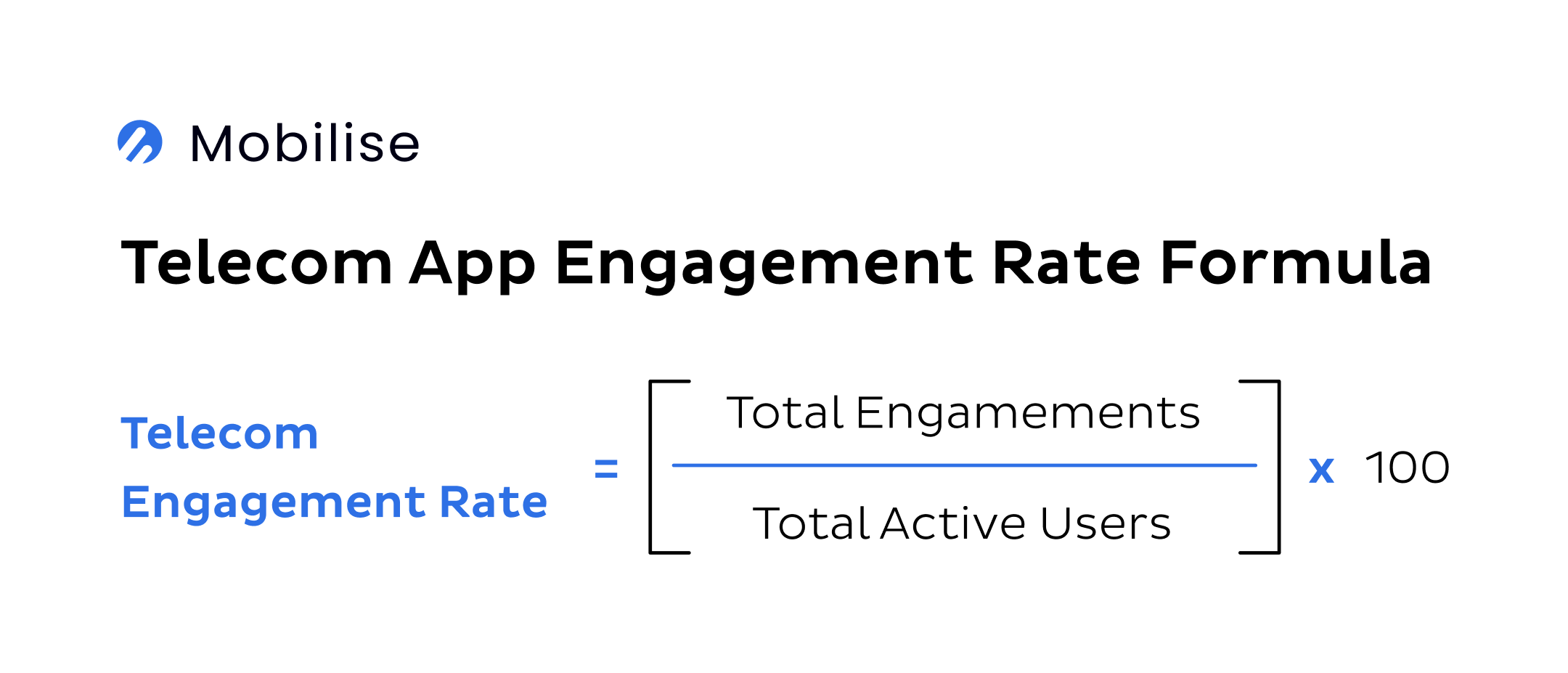
What is a good telecom app engagement rate?
A general standard for all apps, regardless of the industry it operates in, is between 1% and 5%. However, some industries experience higher app engagement rates than others.
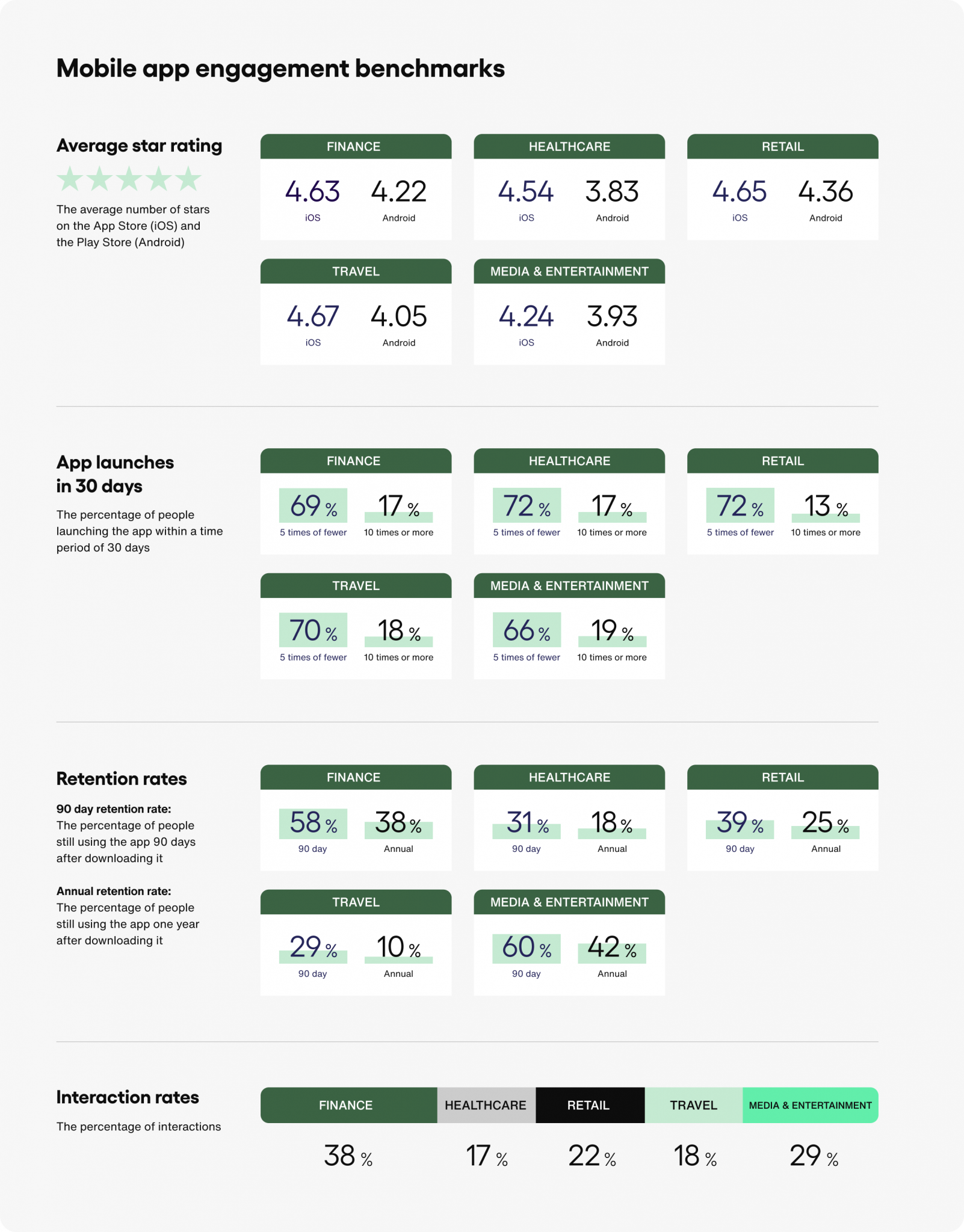 Source: SendBird
Source: SendBird
Why is app engagement rate important in telecom?
According to research by Think with Google, 71% of pre-paid and 58% of post-paid consumers prefer to engage with telcos through mobile apps. In the market under the research, pre-paid users dominate the market, with an average of 88% of all plans being pre-paid and mostly purchased by 18 to 35-year-olds.
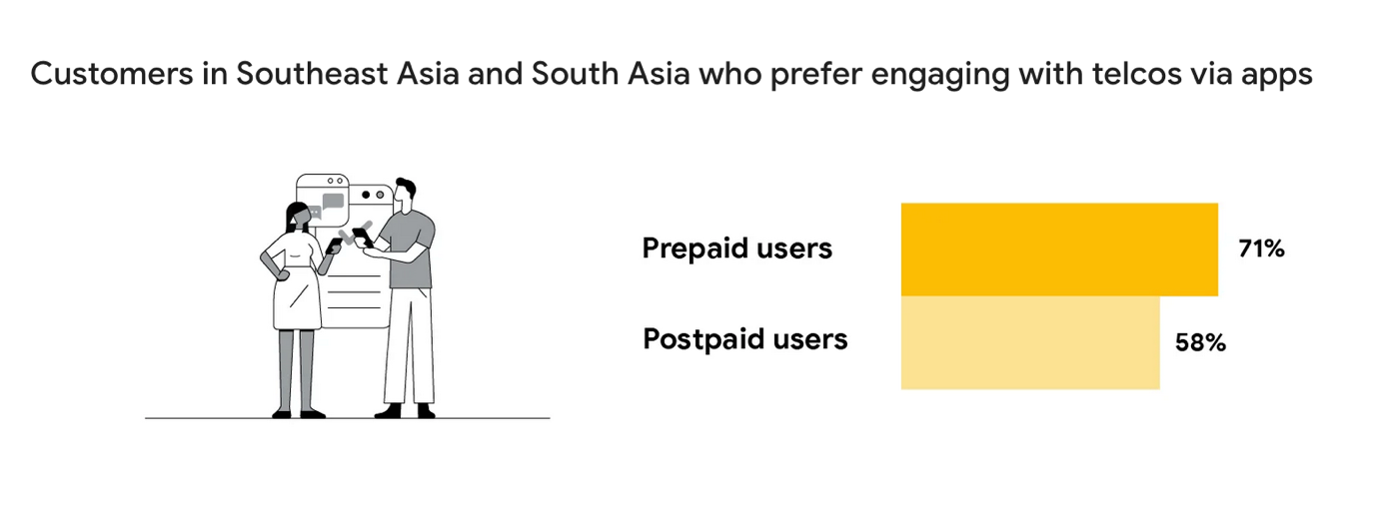 Source: Think with Google
Source: Think with Google
Even though the two groups have different ways of engaging with telecom apps, both see it as a very important tool to connect and interact with their telco provider.
It’s therefore crucial to learn what those differences are, how people view telecom apps and how they prefer to interact with them. Investing into those insights can improve telecom app engagement rate and thus boost loyalty, retention, and overall satisfaction with mobile providers.
In the following section of this blog, we’ll identify 10 strategies telecom companies can apply to improve engagement in their apps and keep customers coming back for more.
How to Improve Telecom App Engagement Rate?
Diving deeper into the research by Think with Google, it appears that currently, users perceive telco apps as utility tools. That’s likely due to mobile internet access becoming an essential service for both consumers and businesses alike and consequently is perceived as a utility service.
However, telco apps can be more than just utility tools. 3 in 4 app users favour a single telco app that features multiple and diverse functions and features. That includes entertainment content, rewards, and games. Therefore, broadening app functionalities can enhance telecom app user engagement, subsequently boosting brand affinity, which surges by 40% as users transition from app awareness to onboarding. This then translates to 31% when onboarded users evolve into regular app users.
Extending app functions is one thing, but it’s the delivery of a satisfying app experience that engages app users and keeps them coming back regularly.
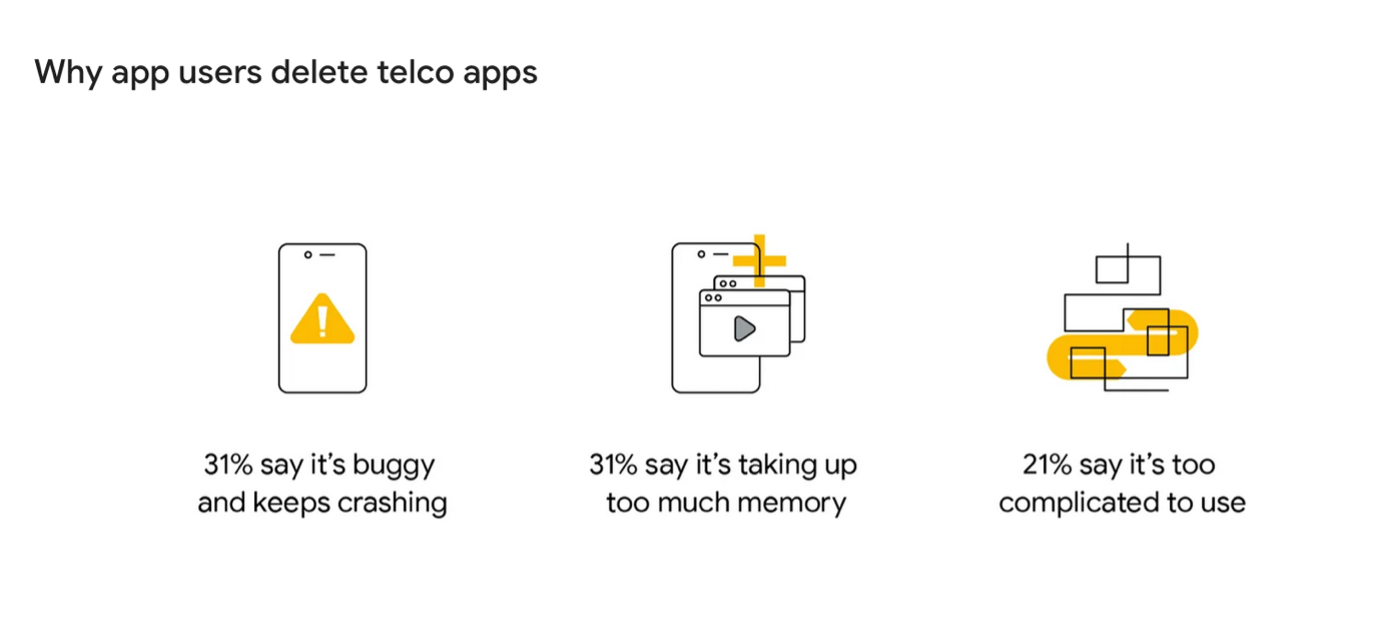 Source: Think with Google
Source: Think with Google
Here are 10 ways in which telecom operators can boost their app experience and influence brand perception, fostering the growth of user loyalty.
1. User-friendly Interface
People do judge a book by its cover and the app by how easy and intuitive it is to use and navigate. A seamless and intuitive interface improves user satisfaction and encourages longer app usage.
People DO judge a book by its cover. We may have the best product, the highest quality, the most useful software, etc.; if we present them in a slipshod manner, they will be perceived as slipshod; if we present them in a creative, professional manner, we will impute the desired qualities.
Steve Jobs
There are several tactics telcos can implement to create a seamless interface:
Simple navigation
If navigating your app makes you feel like you’re lost in a maze, it’s not a good sign. Too many buttons, menus and pop-ups are just as bad as an oversimplification that makes your users unable to find basic features. The result? Abandonment, churn, bad app store reviews. And, of course, low app engagement rate.
In today’s fast-paced world, users expect a well-designed and intuitive navigation system that will enable them to effortlessly navigate through different screens, features, and functionalities.
For the best experience, ensure your app navigation is gesture-based. That means it revolves around gestures like taps, swipes, and pinches. The more familiar the gestures, the easier it is for the user to navigate your app. Similar logic applies to adopting familiar navigation patterns like hamburger menus and bottom navigation bars.
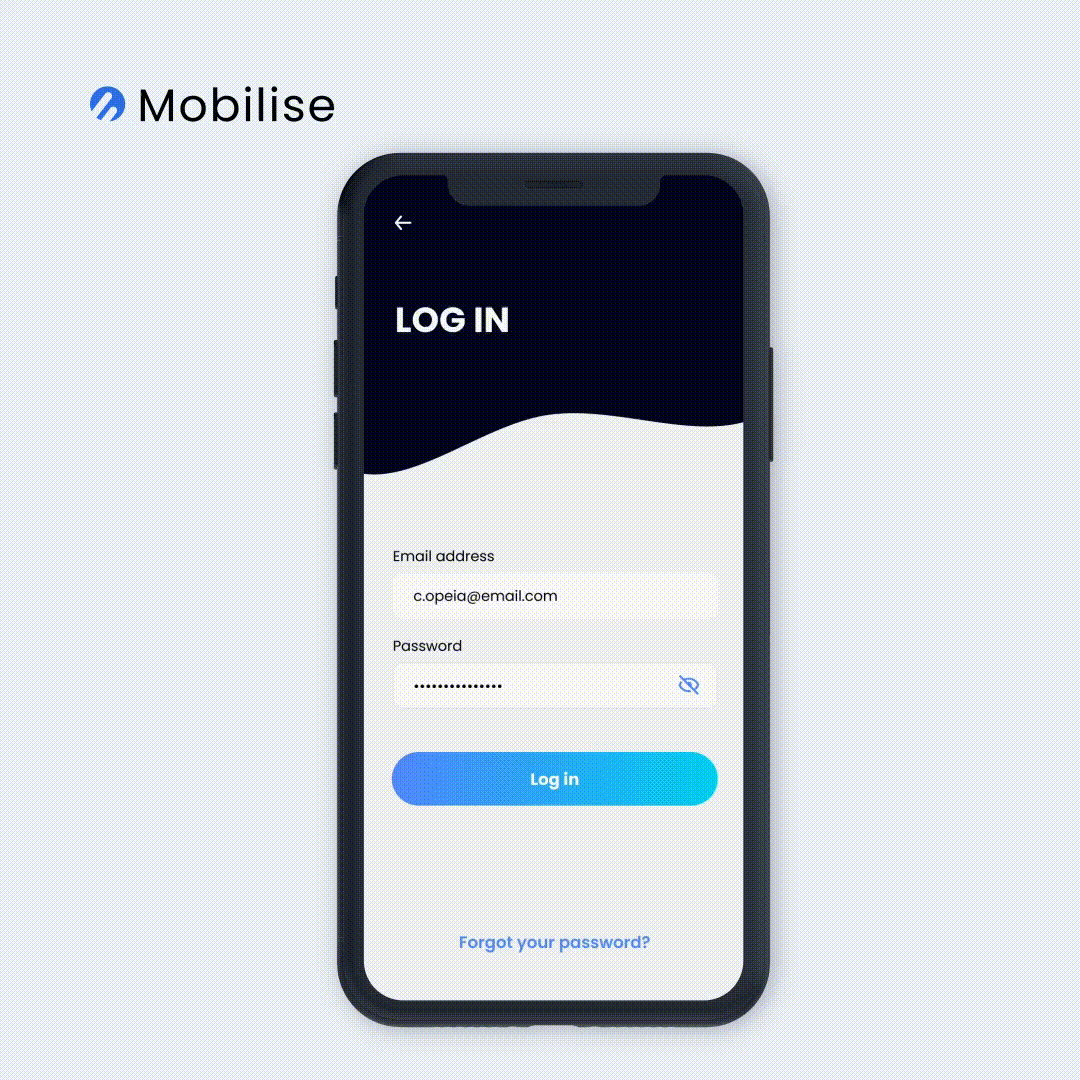
Furthermore, focus on clear information hierarchy. Group-related features (like adding a new payment option and viewing your bill) and prioritising the most frequently used functionalities (like checking the remaining balance). Optimise the menu to provide users with quick access to various sections of your app.
Lastly, the navigation and the menu should be visually appealing, concise, and organised to reduce cognitive load and enhance the overall user experience.
Applying those tactics creates a seamless navigation experience and optimises app performance by reducing user frustration, minimising user errors, and can improve telecom app engagement rate.
Consistent design
Consistency is the principle that all elements of the user interface (UI) should look and behave in the same way across different parts of any product, including mobile apps.
Consistency in design fosters familiarity and establishes a sense of trust and reliability, enhancing the overall user experience.
On the contrary, inconsistencies lead to usability issues. For example, if the same action is referred to by different terms in different parts of the product, it can cause confusion for users and slow down their workflow, or worse, make them abandon the app altogether.
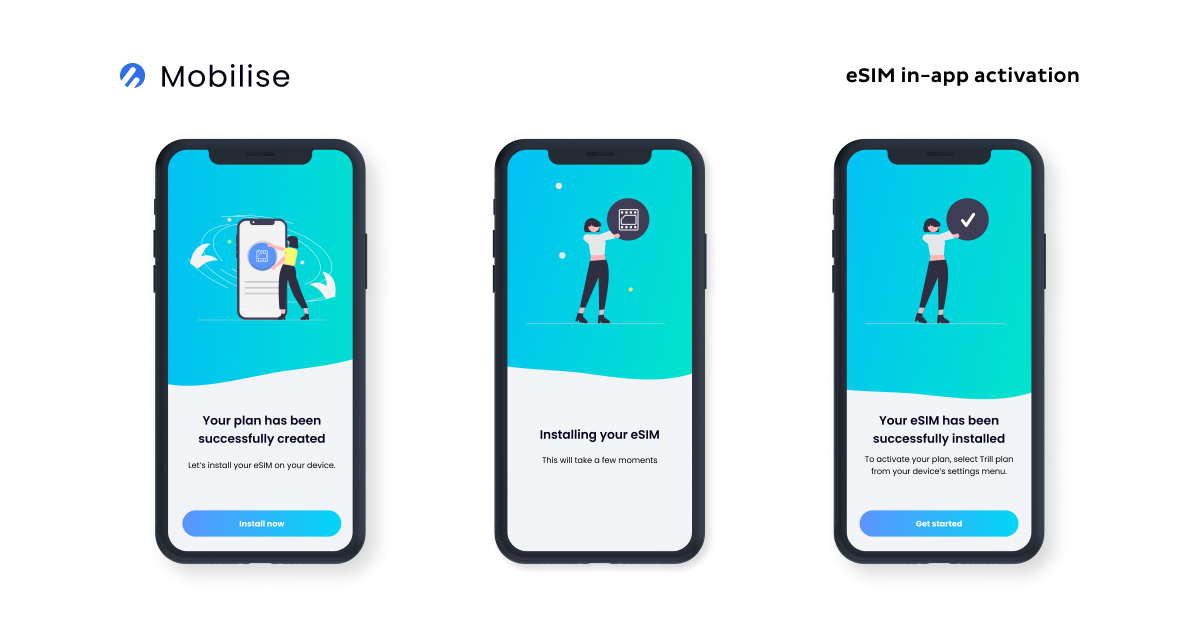
Consistency should be maintained in elements like labelling, messaging, typography, colour, layout, and interactions. For example, if the app uses blue text for clickable links on one screen, it should use blue text to indicate clickable links throughout the entire app.
Because the app is consistent, users quickly become familiar with its design patterns and know how to accomplish tasks efficiently.
To build a consistent app, we recommend creating a style guide that will define the visual aspect of the app and could be used as a guide for all design decisions. Another useful tip is to create a design system for your app. It’s a collection of reusable components or building blocks that will help build any interface, screen, or app, ensuring consistency in execution.
 Source: Andrew Coyle
Source: Andrew Coyle
Accessibility
There are 5.35 billion internet users, and accessibility is their prime concern.
Mobile app accessibility refers to making the app accessible to everyone, including users with disabilities. It emphasises inclusivity – as reported by the World Health Organization, 1.3 billion people, or 16% of the world’s population, experience significant disability. Therefore, neglecting accessibility in app design excludes a large portion of the users, which may lead to potential business losses.
There are four principles known by the acronym POUR that are the main guidelines for creating accessibility in apps:
- Perceivable – ensuring all users can perceive the information presented in the app, which means providing alternatives for users with, e.g. larger font or text-to-speech options for users with visual impairments.
- Operable – ensuring all components of the app, like interfaces or navigation, can be operable by all users. That means testing your app for any elements that may cause photosensitivity in users with epilepsy.
- Understandable – ensuring interfaces can be understood by all users, including those with learning or cognitive disabilities. That includes avoiding jargon and complex grammar.
- Robust – ensuring the app can be accessed on a variety of devices and its content can be interpreted reliably by a wide variety of user agents, including assistive technologies for users, e.g. wheelchair users.
Applying those principles to mobile app design ensures not only an enhanced app engagement rate but also a good impact on brand reputation, customer loyalty and increasing revenue.
2. Personalisation
People don’t like to feel like a number. To be precise, 84% of consumers prefer a more individual approach; otherwise, they are more likely to churn. To increase the time they spend on your app, try designing an experience that is tailored to your users’ individual needs.
It may sound complicated, but there are plenty of seemingly insignificant aspects that can boost the level of personalisation of your telecom app. You can simply start calling your users by their names, let them create and edit their profiles, or add a profile photo.
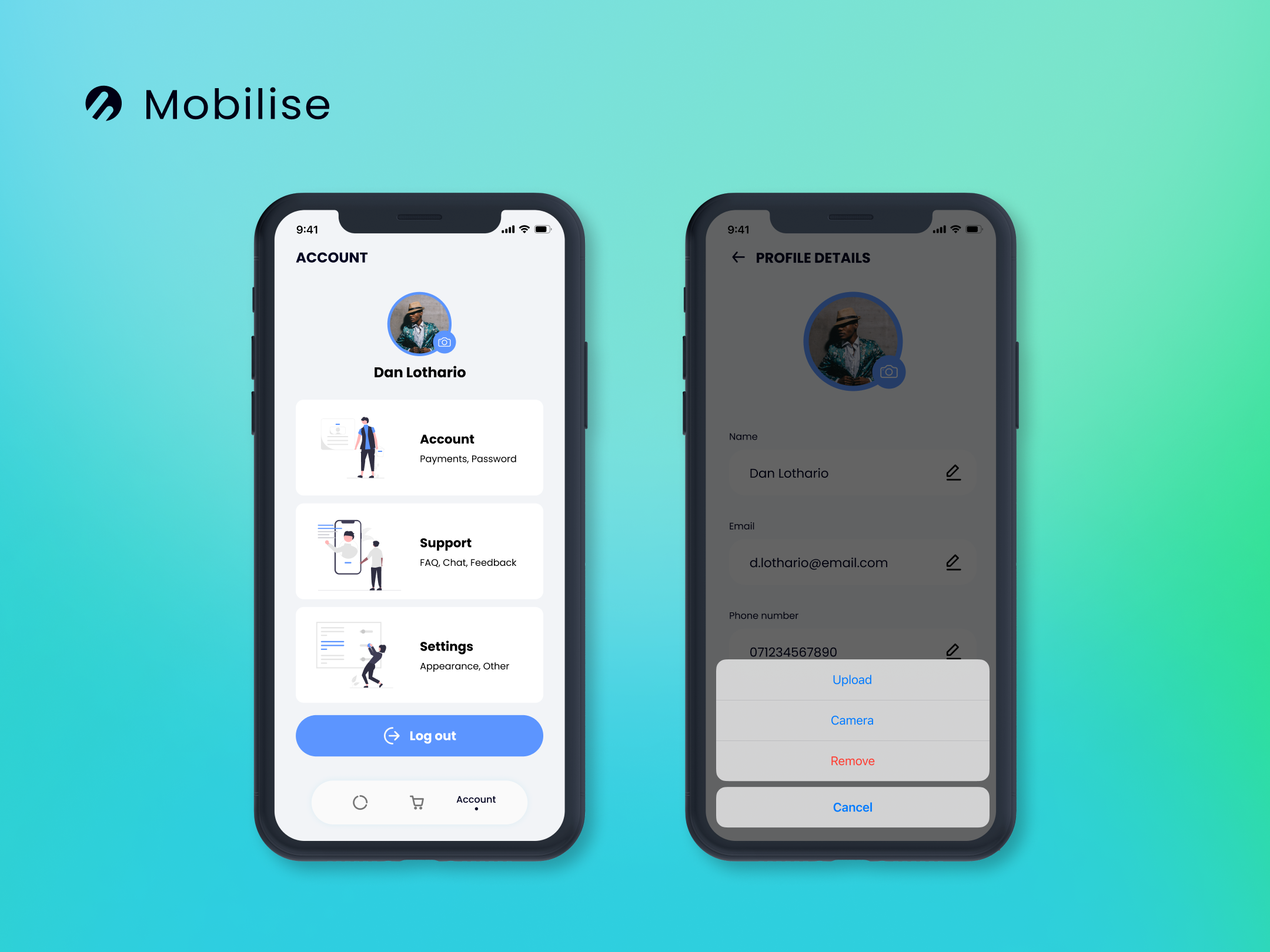
Another strategy is to provide personalised offers and recommendations based on user activity and interest. For example, you can offer custom plans tailored to your users’ individual or business needs, preferences, and budgets. This approach involves providing flexible options that can include varying amounts of data, voice minutes, text messages, and even international calling packages.
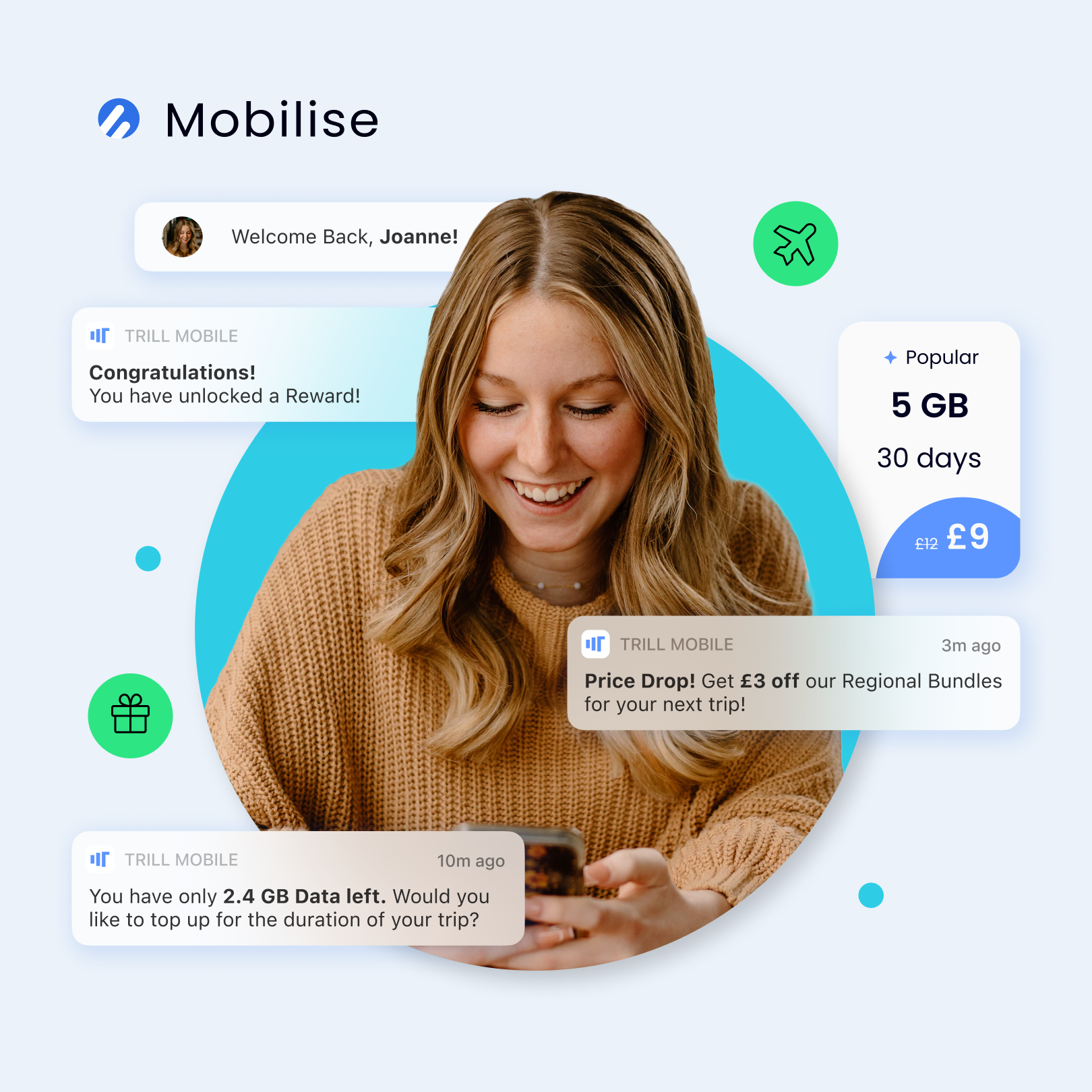
Lastly, you can use dynamic content to deliver targeted messages and promotions. That involves updating content in real time based on the data collected about the user’s current and past activities. For example, if a user has been browsing international call plans, the app could dynamically offer a special discount on an international calling package as soon as they next open the app.
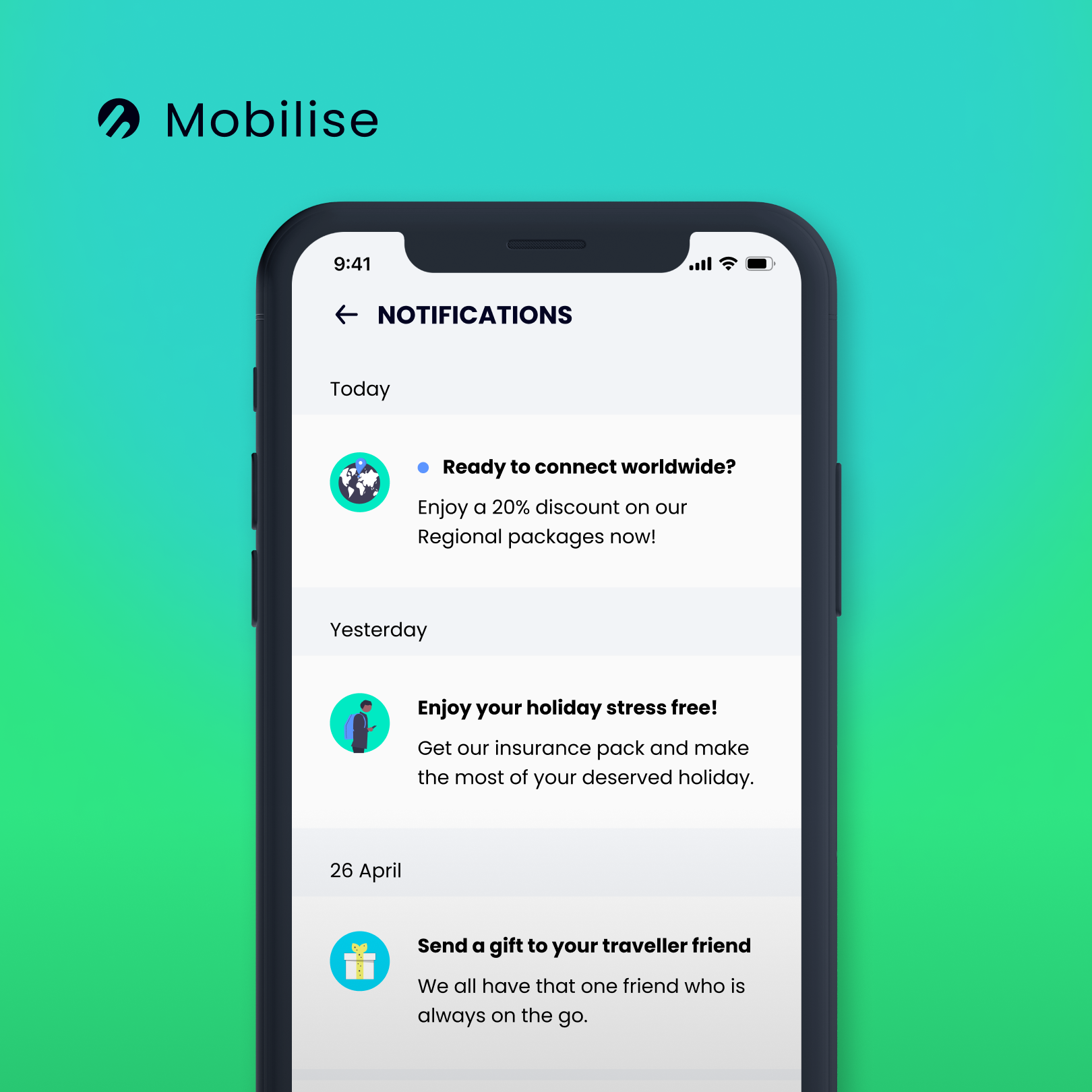
Mobile app personalisation enriches telecom customer experience, which has a positive impact on app engagement and user retention. It also provides a competitive advantage, and personalised offers can help increase ARPU in telecom.
3. Gamification
To win over younger user segments, telecom companies should focus on providing immersive app experiences that include entertainment content and games. That’s where gamification comes in.
Gamification is the process of incorporating fun game elements into an experience (as opposed to turning the experience into a game) to boost user engagement and activity.
Gamifying the in-app experience and offering rewards can significantly enhance the telecom app engagement rate. For instance, in-app reward redemption is favoured by 49% of post-paid app users and 45% of pre-paid app users. Therefore, telecom companies can encourage customers to frequently revisit their apps by offering a variety of perks, prizes, and rewards.
How can telecom companies use gamification? The options are unlimited. It’s up to your team’s imagination; however, make sure to take your audience’s insights into consideration.
Additionally, there are plenty of apps in the app marketplace to get inspiration from (looking at you, Duolingo, Khan Academy, Habitica, and Forest). The most popular gamification elements include:
- Badges – These visual achievement symbols showcase users’ milestones, reflecting their progress and accomplishments within the app.
- Levels – These represent different stages or levels within the app’s framework. As users advance through each level, the app becomes more challenging, encouraging continued engagement.
- Performance Graphs – Visual representations of users’ performance over time, allowing them to track their progress and compare it to previous results.
- Experience Points (XP) – Basic rewards/points awarded to users as they achieve certain goals or milestones within the app, motivating continued engagement and progression.
- Leaderboards – Rankings of users based on their performance, providing a competitive element and encouraging users to strive for the top positions.
- Virtual Currency – In-app currency used to unlock various benefits or features within the game. Users can earn this currency through accomplishments or daily bonuses, enhancing their experience and incentivising engagement.
Gamification isn’t a commonly used tactic in telecoms, but some operators have tried it before. For example, Vodafone leveraged gamification in their app by offering virtual currency, challenges, and leaderboards to encourage users to interact with their app, participate in promotions, and access exclusive content. All of these factors aided in driving customer satisfaction and loyalty.
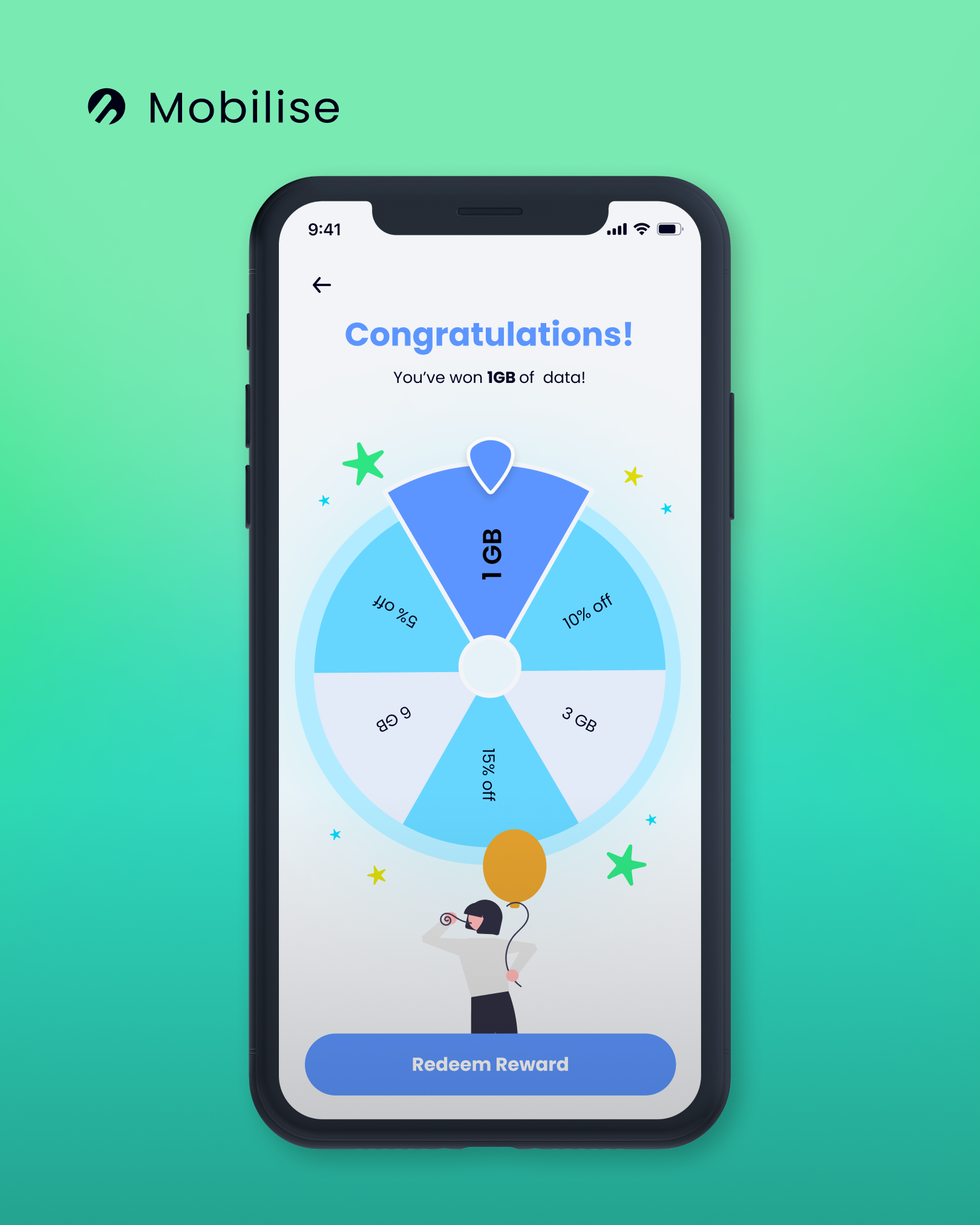
4. Push Notifications
A push notification is a type of alert generated by a mobile app when the app isn’t opened. Push notifications are timely and relevant and used to notify the user about new messages, updates, limited-time offers, and more. When executed well, push notifications can encourage the user to return to the app and engage with its contents.
Push notifications are, therefore, a great strategy to improve telecom app engagement rate. Below are a few ways in which telecom operators can achieve it.
Going back to personalisation, operators can use push notifications based on user preferences and behaviour to offer notifications aligned with the individual’s preferences, activities, or past behaviours, which makes them more relevant and less likely to be perceived as spam. For example, if a user frequently tops up their data towards the end of the month, the app can send a personalised reminder when they are nearing their data limit or offer a timely special on data top-ups.
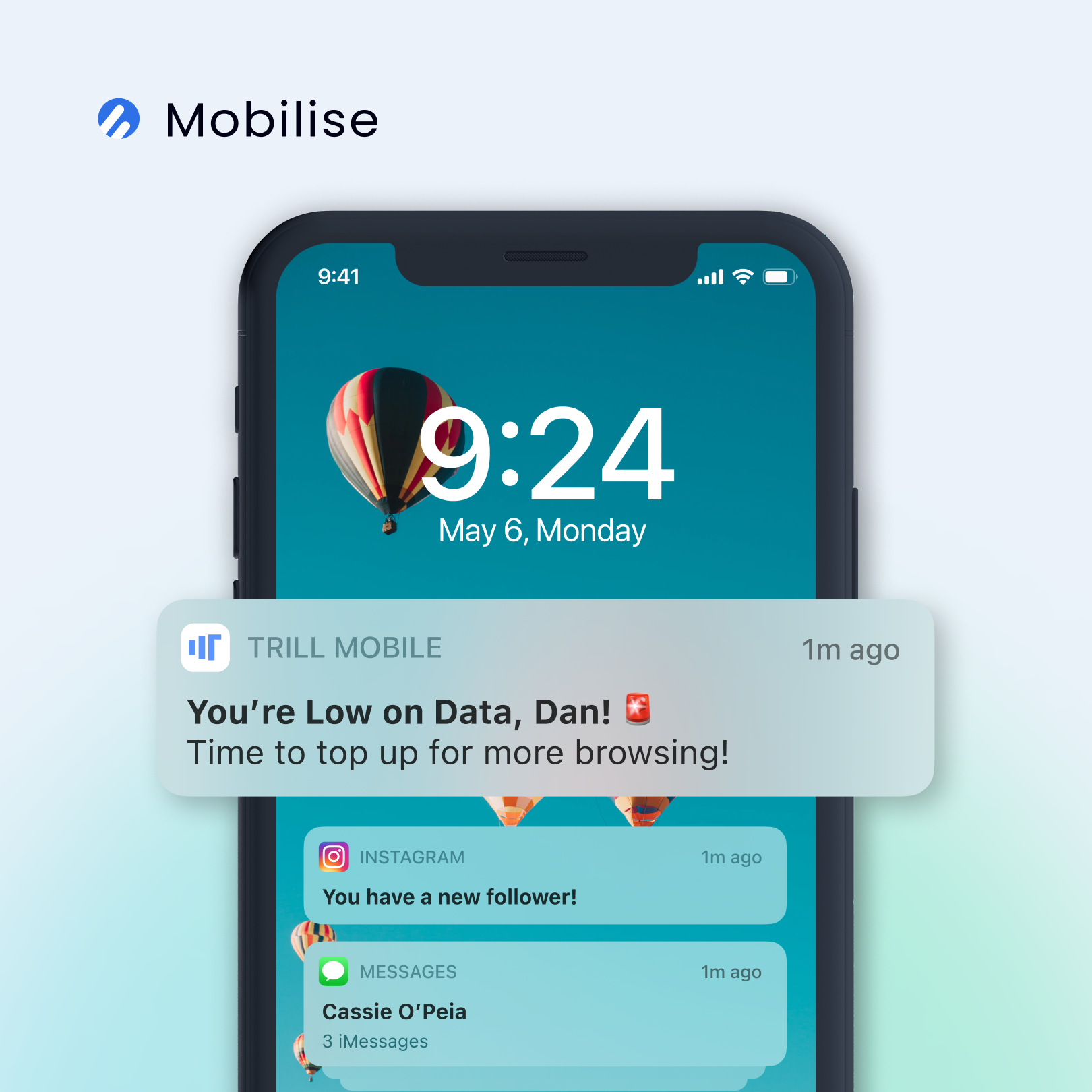
Alternatively, push notifications can be used to update users about new app features, promotional offers, or important updates to encourage continued engagement and exploration of new functionalities. When an operator adds a new add-on to their offer, for example, a new video streaming service, the app can send notifications to users, possibly with a special introductory offer to boost uptake.
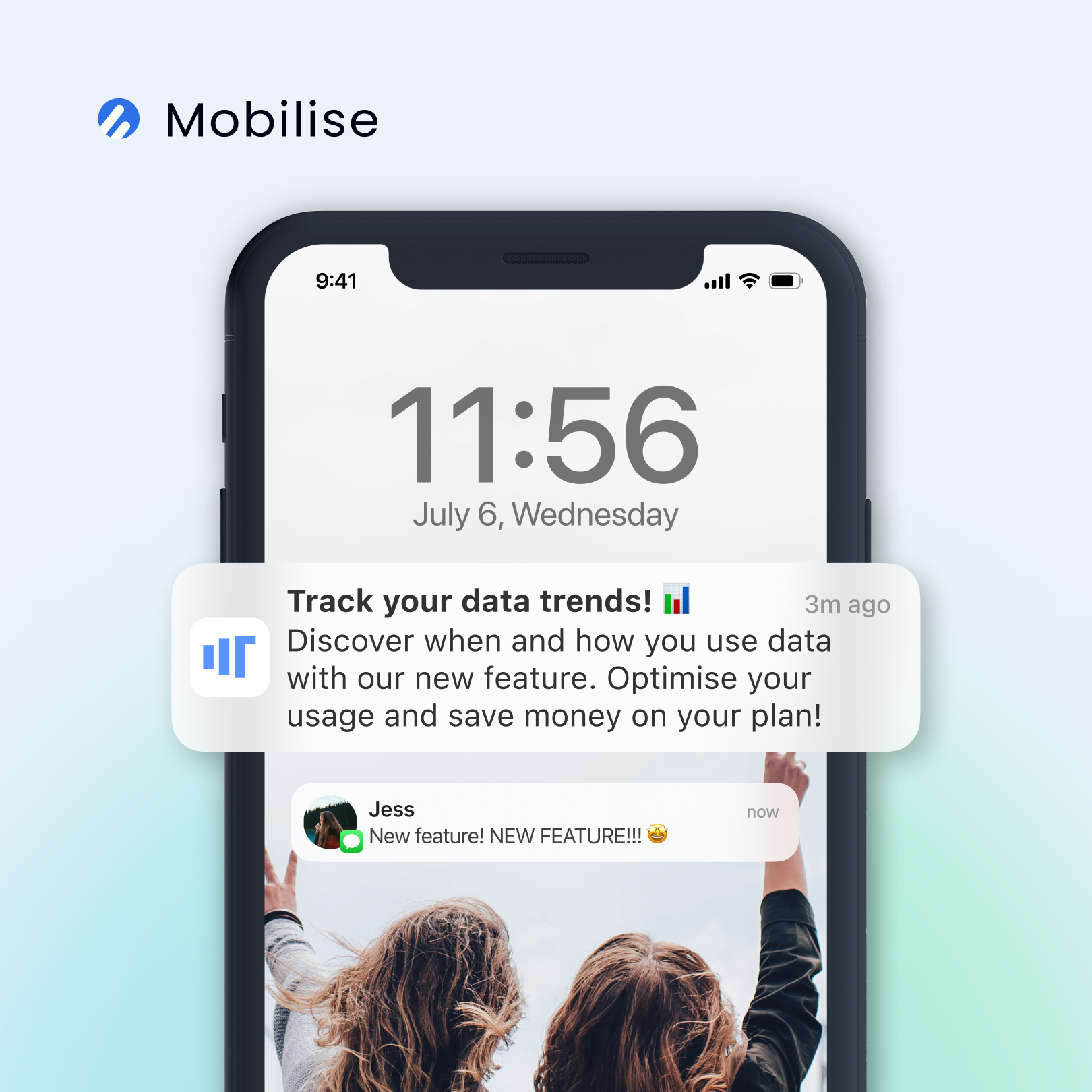
Push notifications can also be used for more mundane yet important reasons, like reminding users of necessary actions, such as bill payments or renewal of subscription plans, to add convenience and enhance user satisfaction. Operators can set up automated alerts to remind users a few days before their bill is due or their plan is about to expire, with a direct link to complete the action within the app.
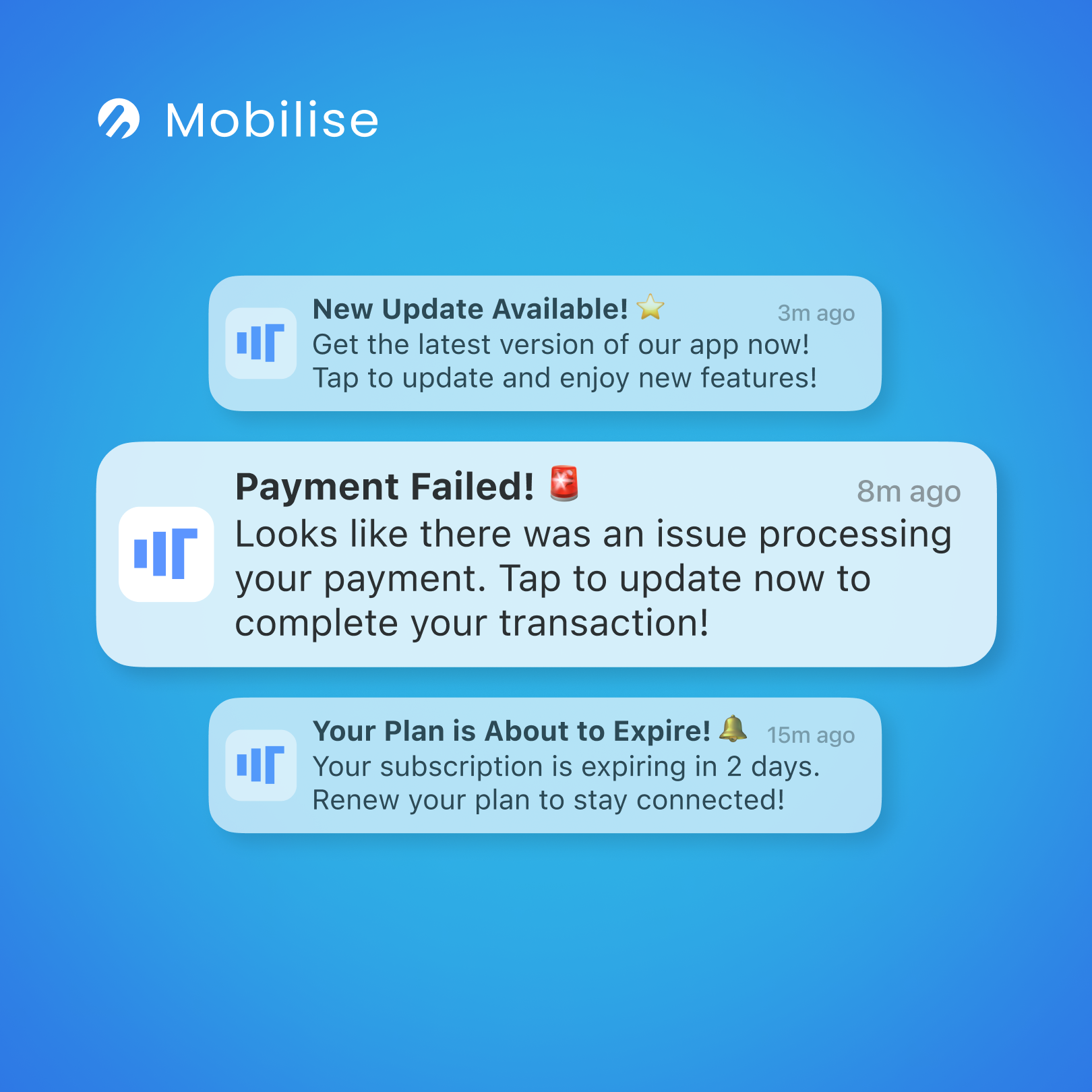
By strategically using push notifications, telecom apps can maintain a continuous connection with their users, promoting both satisfaction and loyalty. This proactive communication helps ensure that users are always informed and engaged with the latest offerings and features, enhancing their overall app experience and boosting the telecom app engagement rate.
5. Interactive Features
Interactive features tend to go unnoticed, but they surely enrich the user experience by making app interactions more engaging and responsive. These features not only entertain but also empower users to actively participate in their telecom services. Here’s how telecom apps can benefit from incorporating interactive elements:
- Integrate Interactive Tools such as Quizzes, Polls, and Surveys – These tools engage users and provide valuable feedback that can guide improvements and innovations within the app. A quiz to test users’ knowledge about data security with instant feedback can educate them while engaging them. Polls can ask users to vote on new app features they want most, ensuring users feel their input is valued.
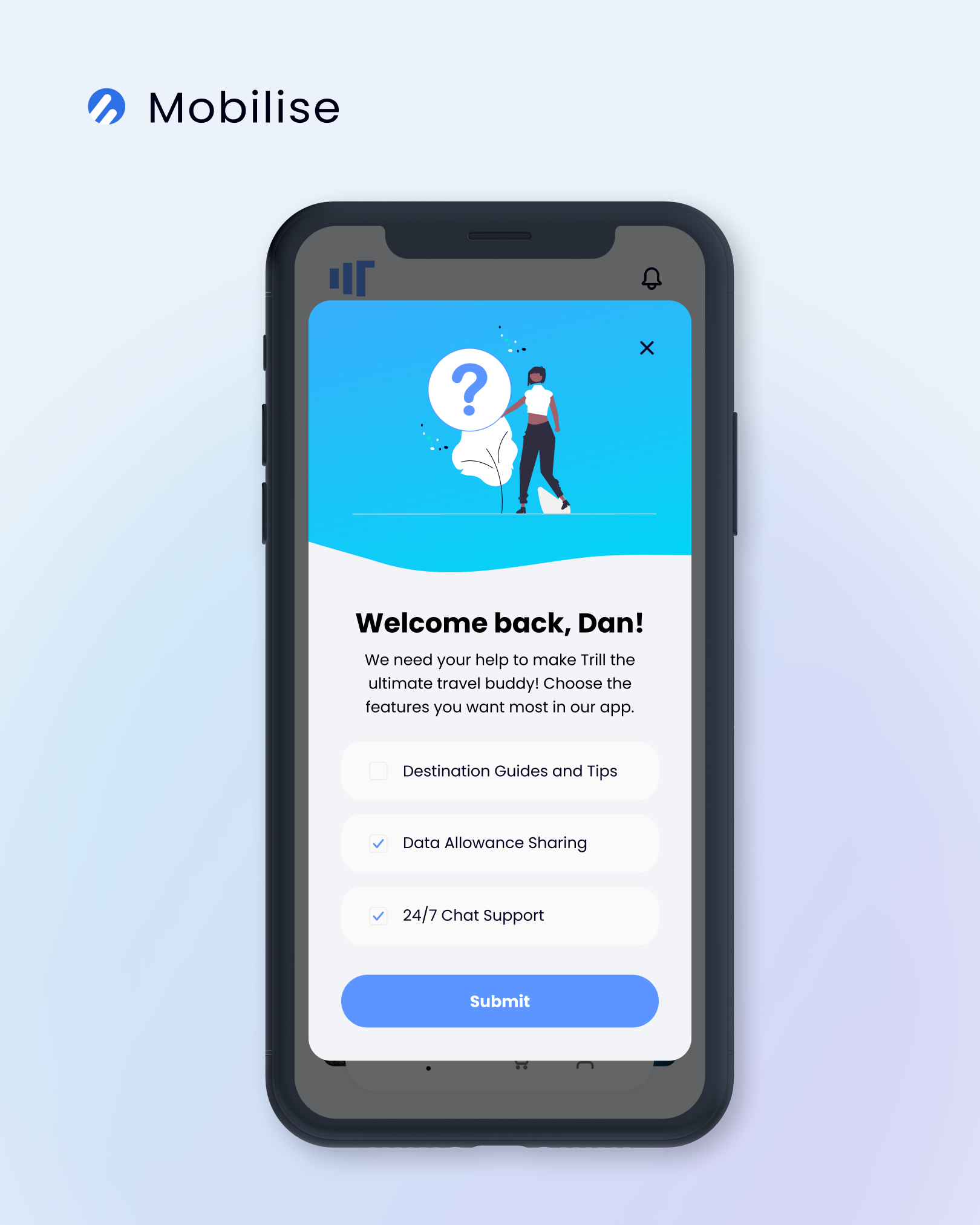
- Enable Social Sharing Features – Allowing users to share their experiences or achievements on social media can turn users into brand ambassadors and attract new customers. For example, features that allow users to share their savings or benefits from using the app with friends on social media can help spread word-of-mouth endorsements and incentivise new user sign-ups.
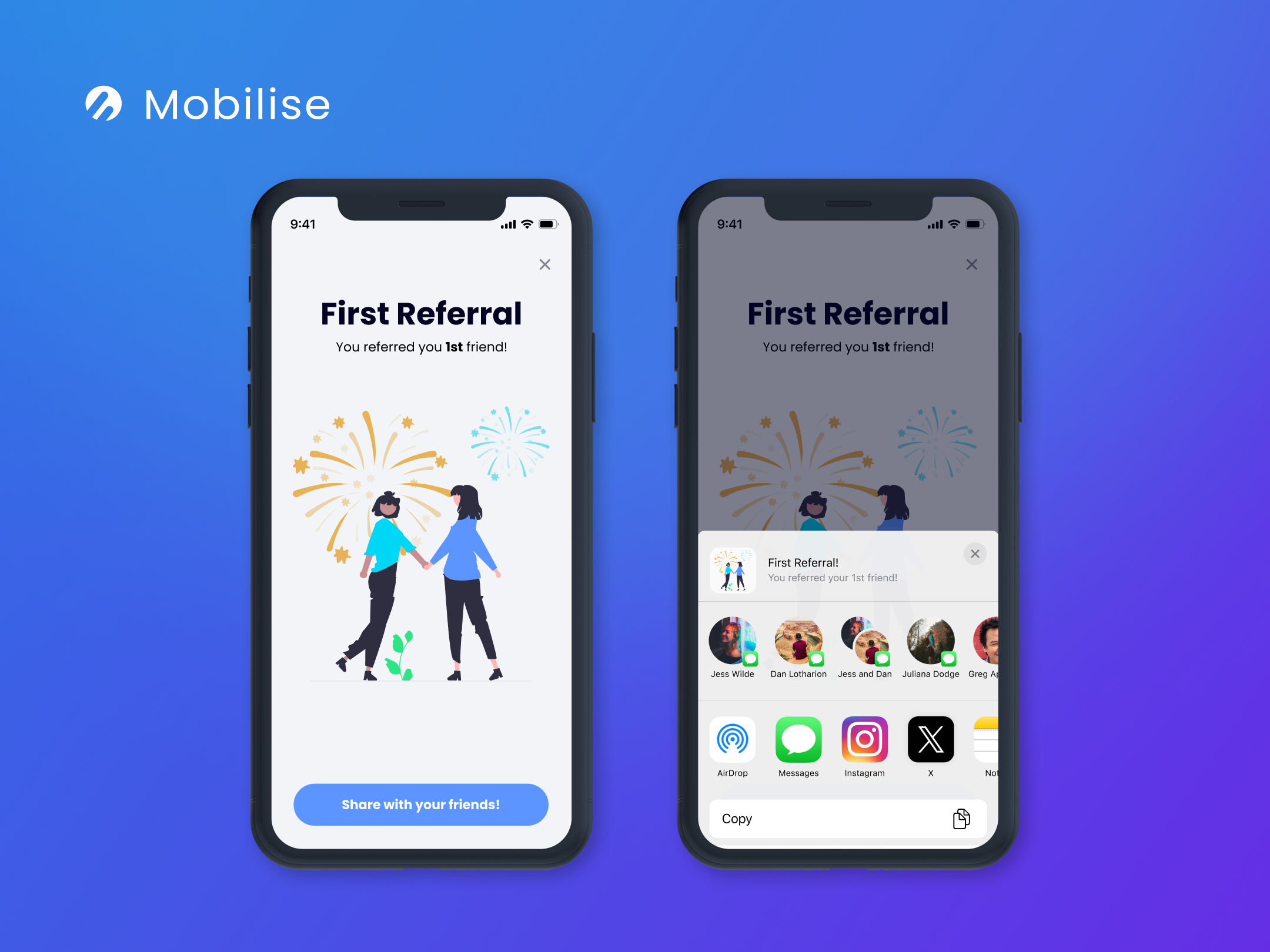
- Incorporate Interactions like Swipe Gestures and Touch Animations – Adding playful and intuitive interactions, such as swipe gestures for checking usage or toggling between services, can make the user experience more enjoyable and fluid. Users could swipe through different plan options, with smooth animations displaying plan details, making the process of choosing a plan more interactive and less cumbersome.By weaving these interactive features into the app, telecom companies can significantly enhance user engagement and satisfaction, making the app not just a tool but a pleasurable part of their customers’ digital lifestyle. These features not only keep the user interface lively but also foster a deeper connection between the user and the app.
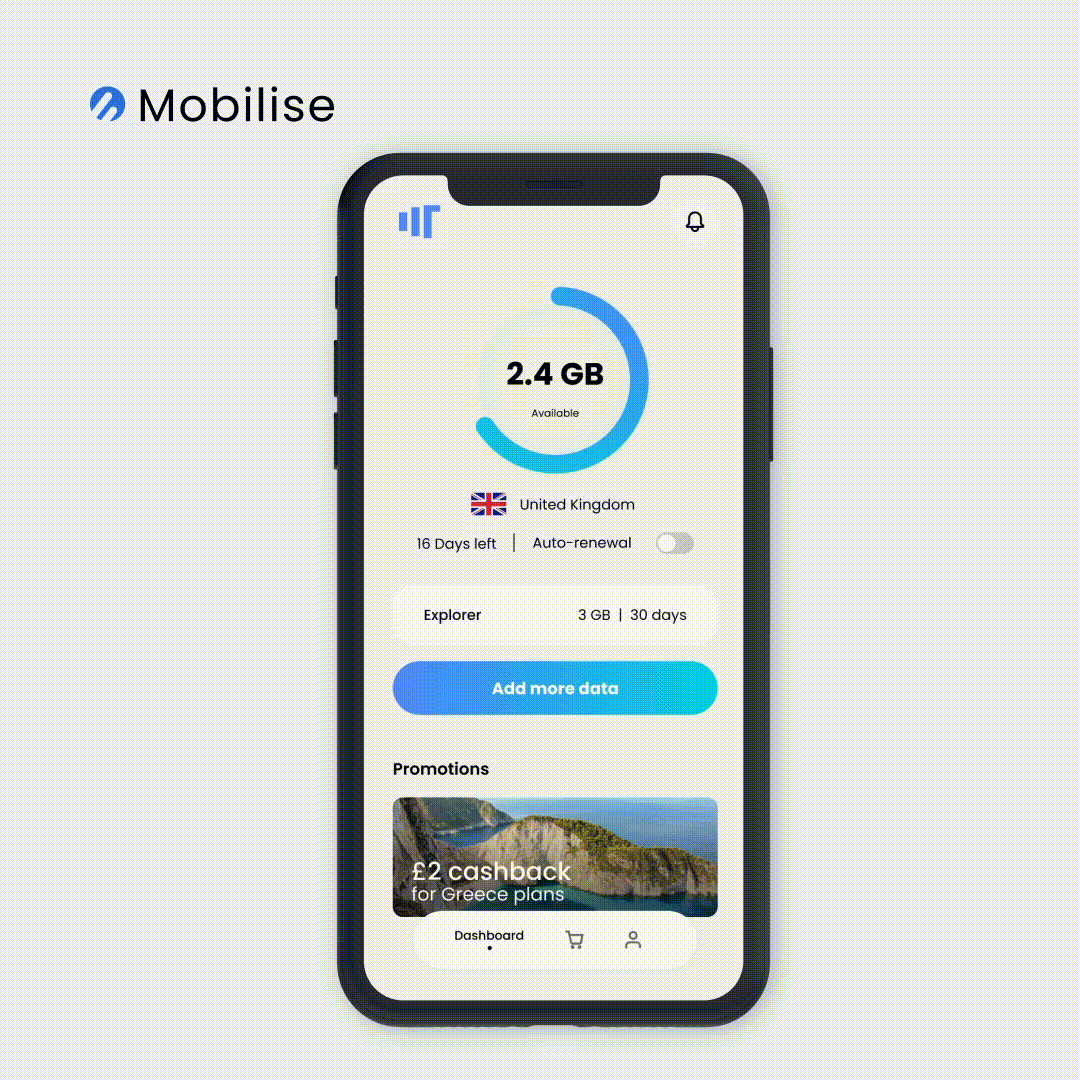
6. Social Sharing
Social sharing means sharing content, like photos, videos, or links, through social media platforms or other digital channels. But how can it help improve telecom app engagement rate? It allows others to engage with the shared content, thus increasing its reach and exposure and building a community around the brand.
By enabling users to share content directly from the app to their social media platforms, telecom companies can leverage their user base to generate organic growth through user-generated content (UGC). Here’s how integrating social sharing can enhance the app experience:
Sharing Buttons for User Generated Content
Telecom app providers can simplify the sharing process by placing visible and accessible sharing buttons throughout the app. It encourages users to share their experiences, deals, or achievements with minimal effort.
After achieving a milestone, like upgrading a service plan or receiving a special discount, users could be prompted with a “Share this on social media” button, making it easy to post directly to their social networks.
Social sharing and sharing buttons can also be paired with gamification. For example, after earning a badge or moving up the leader board, telecom app users can be given the option to share their achievements on social platforms, inviting their friends & family to open the app and participate in the gamified activities.
Showcasing UGC on the app or the company’s social media platforms can help enhance trust among users. 92% of consumers trust reviews and testimonials more than traditional advertising, while 60% stated that UGC is the most genuine form of content.
Incentivised Social Sharing
Another option to encourage users to share telecom app content with their social circles online is to offer incentives, like rewards or exclusive offers, to increase user interaction and improve telecom app engagement rate. This strategy not only promotes the app but also rewards users for their advocacy. In fact, 60% of users say they would create content for a brand if rewarded.
For example, telecom providers can offer their users bonus data or discounts on their next bill when they share an app-related post. Alternatively, they can celebrate milestones and special occasions by offering exclusive offers to users who engage in social sharing activities around these events. This not only capitalises on the festive mood but also ties the brand to positive celebrations.
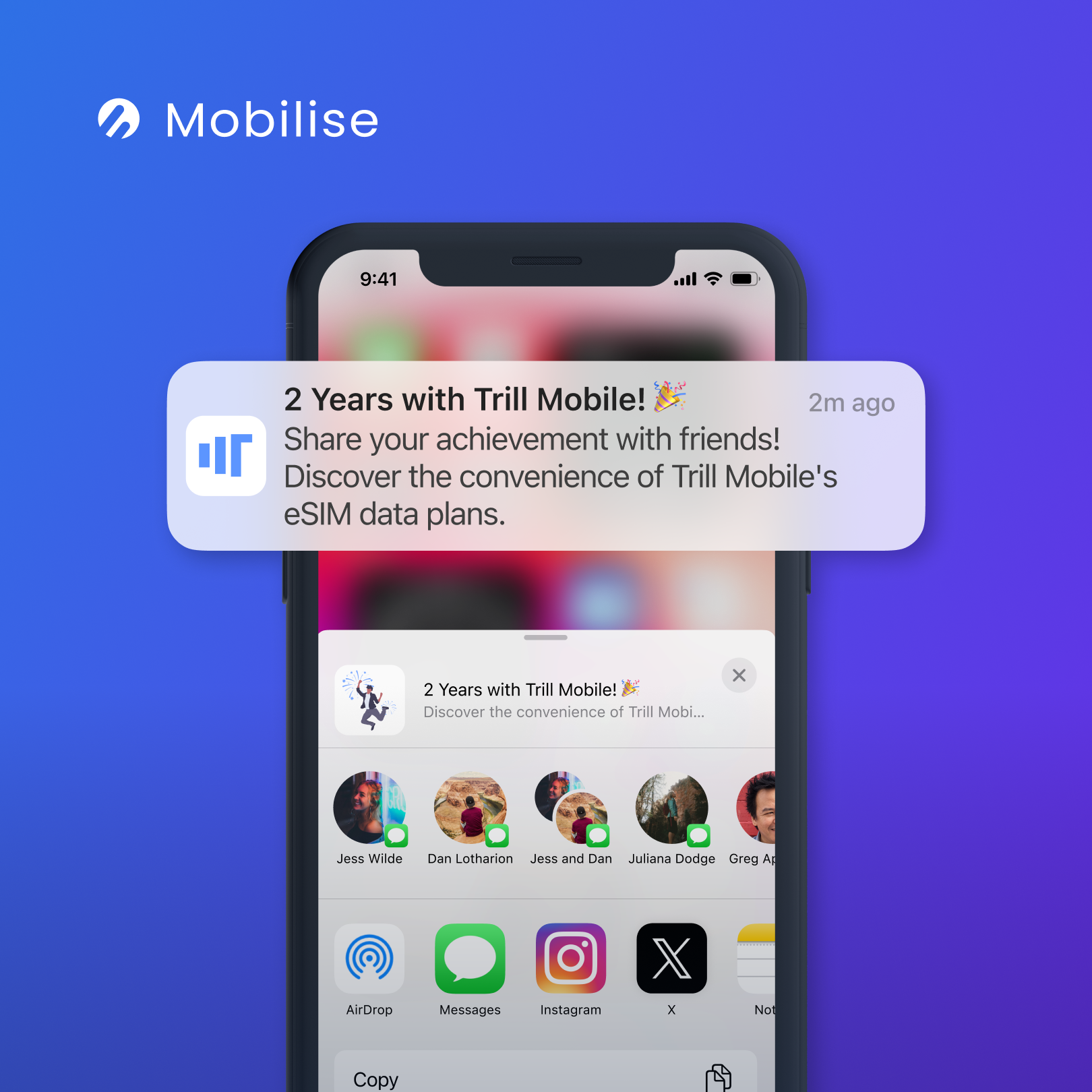
Another idea is to develop a referral program that rewards users whose friend signs up for the service. Operators could create a tiered system where users can unlock higher value rewards, from small data packs or discounts to free subscription months or exclusive access to new services before they are launched to the public, based on the number of successful referrals or shares.
92% of consumers trust referrals from people they know and are 4 times more likely to buy when referred by a friend, which could significantly improve not only the app engagement rate but also brand visibility and new user acquisition.
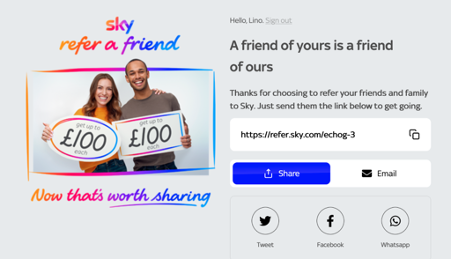 Source: Buyapowa
Source: Buyapowa
7. In-app messaging
In-app messaging, often confused with push notifications, focuses on displaying messages, also known as pushes, inside the app. In-app notifications, or messages, facilitate direct communication between telecom companies and their customers. This tool can be used to deliver personalised interactions, provide support, and promote offers within the app environment.
A good example is an in-app real-time chat feature that provides users with instant access to support for queries or issues. This helps in resolving problems quickly and efficiently, enhancing user satisfaction. According to Gorgias, 79% of businesses say offering live chat features has positively impacted sales, revenue, and customer loyalty. However, it’s worth remembering that 66% of customers expect a response within 10 minutes.
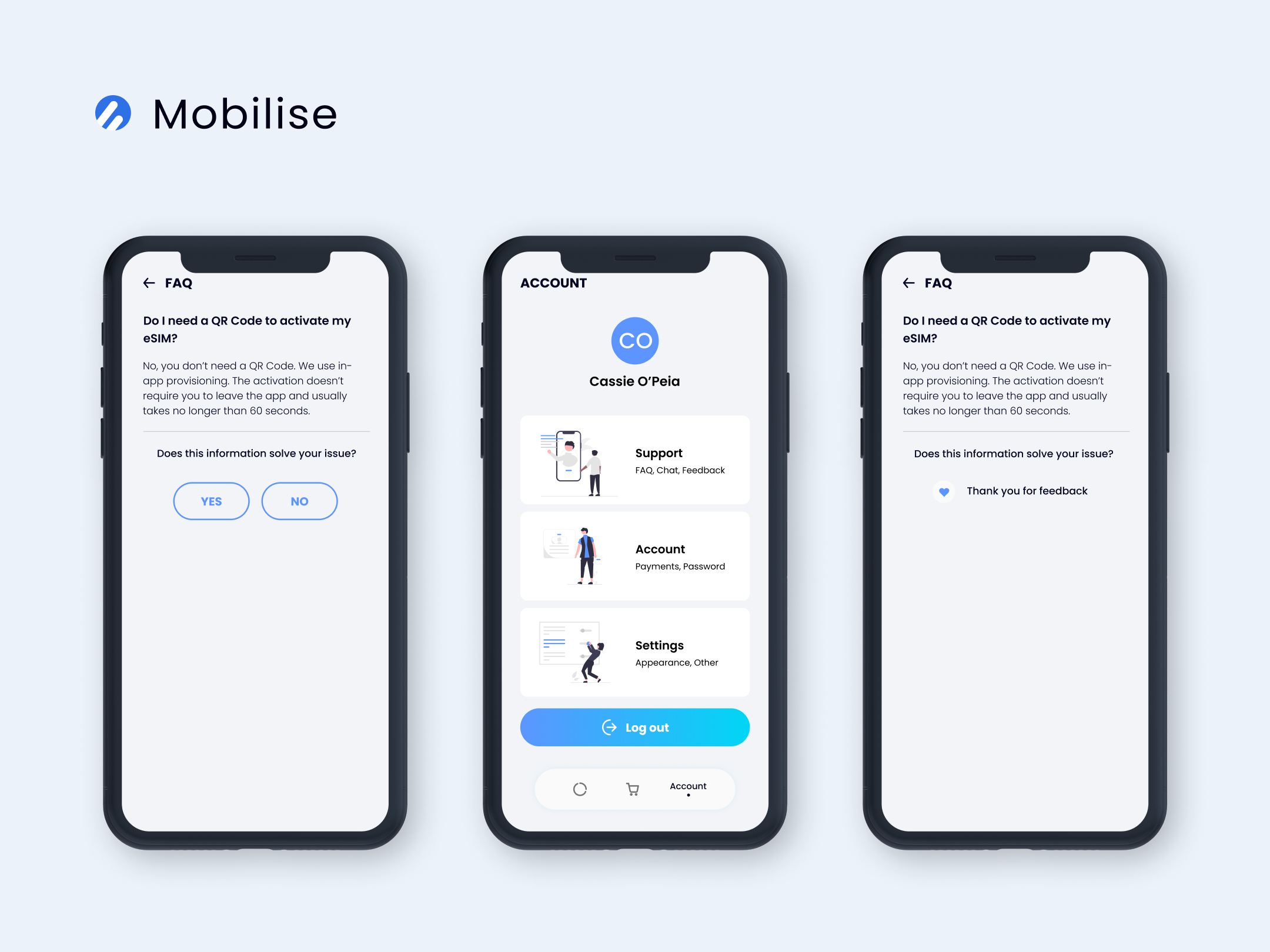
In addition to live chat, operators can implement in-app messaging with personalised offers and recommendations. This technique combines three strategies discussed in this blog: personalisation, data analytics, and in-app messaging, which proves that operators don’t have to implement each strategy one by one to improve telecom app engagement rate. They can become creative and mix and match them according to their needs.
Back to in-app messaging, operators can use it to send personalised messages that cater to individual preferences or needs, such as tailored service plans or contextual promotions. As we’ll discuss in more detail in the next section, consumers value personalisation, and over 70% of them become frustrated when their shopping experience is impersonal. Personalised in-app messaging also makes the telecom app a one-stop solution for customer support and personalised communication, which is what approx. 75% of telecom consumers expect from their operator, as per Think with Google.
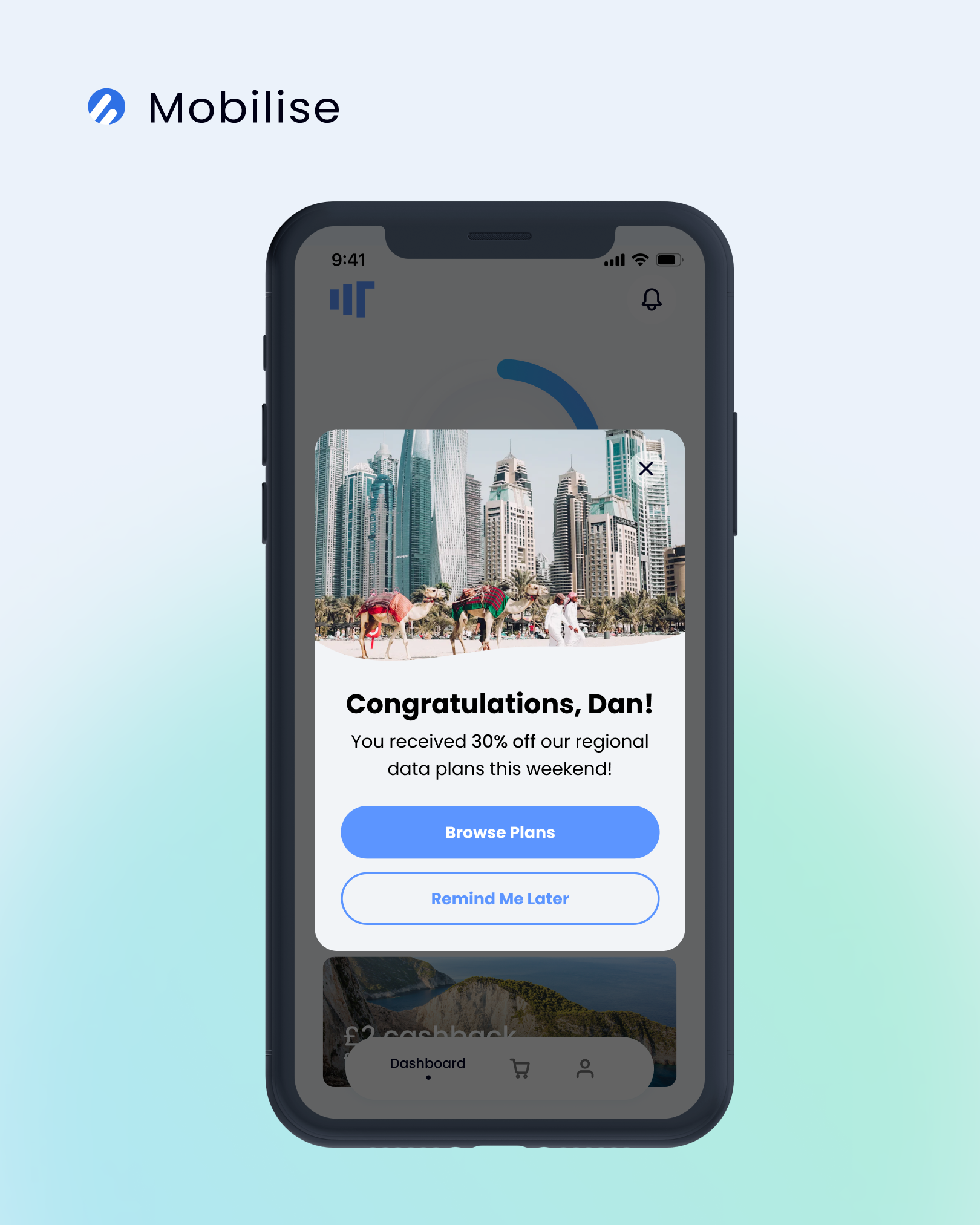
8. Data Analytics
Big data analytics in telecom is crucial for understanding user behaviour, preferences, and engagement patterns within a telecom app. By leveraging data-driven insights, telecom companies can optimise app features, tailor marketing strategies, and ultimately enhance user satisfaction. There are a few ways telecom apps can benefit from incorporating robust data analytics.
Firstly, regular collection and analysis of user data such as app usage patterns, feature popularity, and user feedback can help identify what users value most. These insights can guide the development of new features and the enhancement of existing ones.
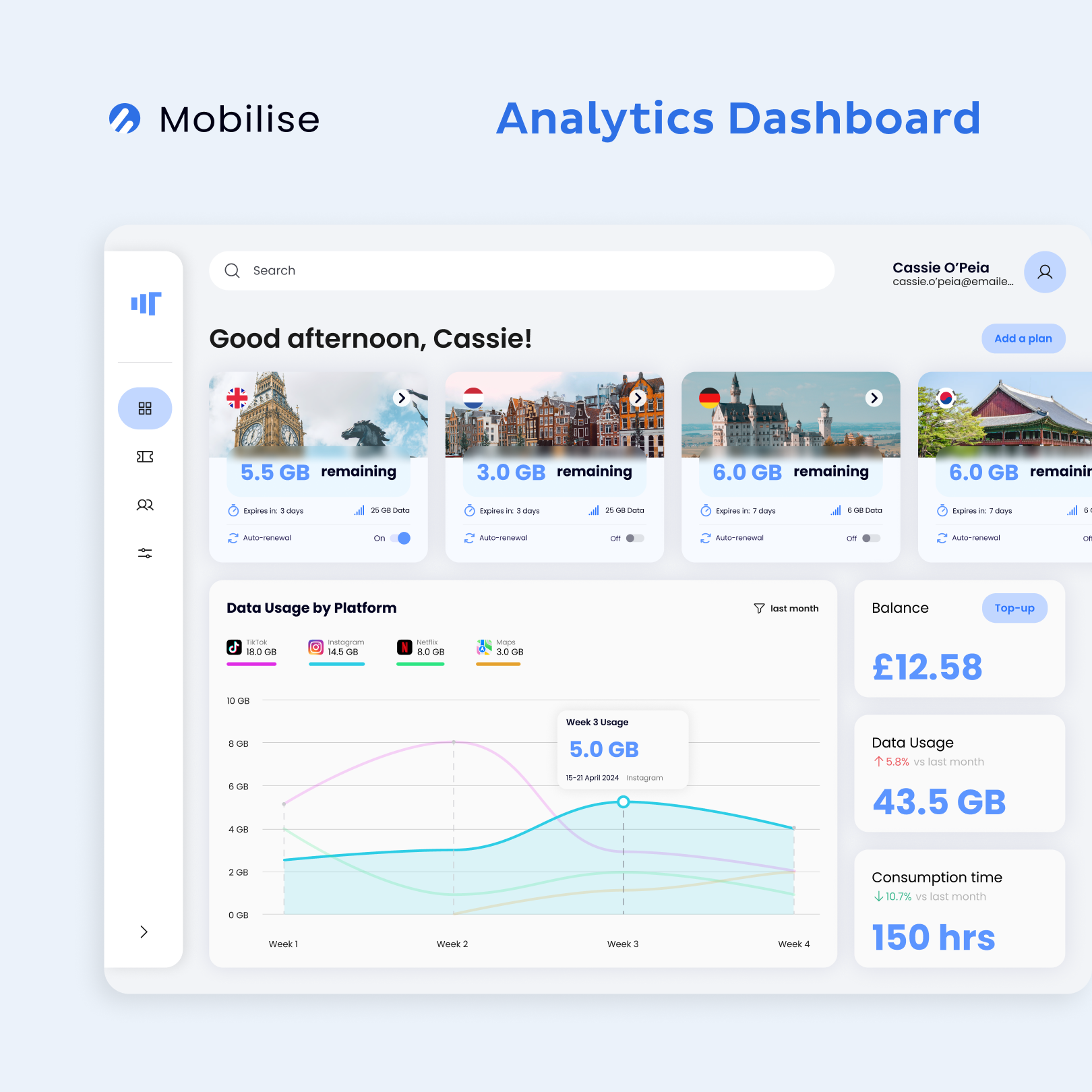
Secondly, operators can easily track key engagement metrics like daily active users, session duration, and retention rates, providing vital information about the health of the app and the effectiveness of engagement strategies. For instance, a drop in session duration might indicate a problem with a recent update that needs to be addressed quickly.
Data analytics insights also aid decision-making processes. If, for example, data shows high engagement with promotional offers within the app, consider increasing the frequency of these promotions or tailoring them more specifically to user preferences indicated by their usage patterns.
Furthermore, the use of data analytics helps to improve telecom customer experience by crafting and delivering more personalised offers and content in the form of push notifications or in-app messaging.
Lastly, data analytics can help telcos predict their user needs and respond proactively. For example, they can predict when users are likely to need more data based on their usage trends and proactively offer them a suitable data add-on package before they reach their limit.
By effectively using data analytics, telecom apps can create a more engaging, personalised, and efficient user experience. This not only drives user satisfaction but also supports strategic business decisions that contribute to the app’s success and longevity. According to MoldStud, businesses that use data-driven insights in app development are 70% more likely to increase user engagement.
Solution
Mobilise has the perfect solution for operators looking to improve their app engagement rate. Our digital BSS platform, HERO, offers all the features and strategies discussed in this article (and more!). From user-friendly interfaces to big data analytics, we offer a range of telecom software solutions that are suited to individual telecom needs.
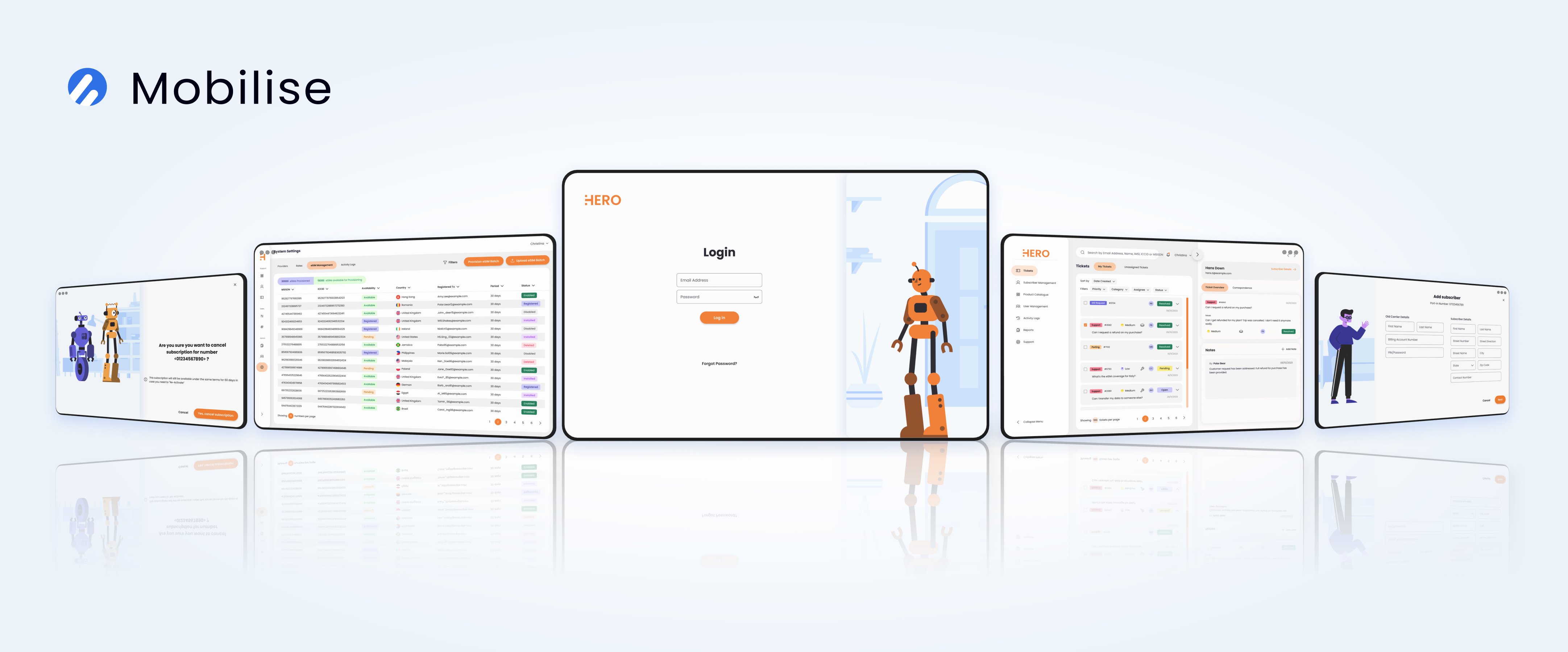
Conclusion
Improving telecom app engagement rate is an ongoing journey that requires continuous effort and adaptation. By implementing the strategies discussed—from creating a user-friendly interface and personalising experiences to integrating gamification and leveraging data analytics—telecom providers can ensure their apps remain relevant, engaging, and valuable to their users.
It’s important for telecom companies to not only adopt these strategies but also to continuously evolve them to meet changing user needs and technological advancements. Ultimately, the goal is to foster an app environment that enhances customer satisfaction and loyalty, driving both business growth and user retention in an ever-evolving digital landscape.



